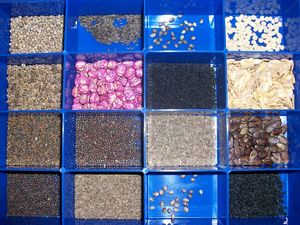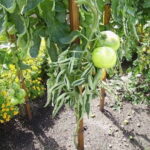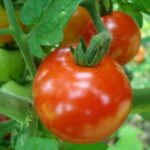Saving seeds from your favorite garden vegetables is a great way to save money, ensure you have a favorite variety growing in the garden and it’s easy and interesting. To save seeds requires little more than allowing the seeds to dry and storing them in a cool, dry place until next season’s planting time.
How to Save Tomato Seeds
Tomatoes are the most popular garden plant and the varieties are endless. When you discover a tomato variety that grows well in your area, resistant to disease and is a family favorite, you’ll want to save some seeds and start your own plants next year.
Pick a ripe tomato, cut it in half and squeeze the pulp into a container. Add two tablespoons of water and let the seeds ferment for four days at room temperature. Stir gently once each day. On day four pour off the water and pulp, then spread the tomato seeds in a single layer on paper toweling and allow to dry thoroughly (at least two days). Place dry seeds in an envelope or glass jar and store in a cool, dry place. Don’t forget to mark each container of seeds with seed name, date harvested and any other pertinent information about the plant the seeds were harvested from.
How to Save Bean or Pea Seeds
Allow a few bean and/or pea pods to remain on the vine at harvest time so the pods can dry out and become viable garden seeds for next growing season. After the pods turn brown, remove them from the plant and spread in a single layer on newspaper in a cool, dry, protected location. Allow the pods to completely dry (between 1-2 weeks) then shell the beans/peas and place them in a brown paper bag. Store in a dry location where temperatures won’t reach over 50 degrees.
How to Save Corn or Okra Seeds
Saving seeds from most vegetables (including corn and okra) are basically the same as saving seeds from beans and peas: allow a few of the vegetables to remain on the vine/stalk/plant until they pass maturity and begin to turn brown. Remove the overly ripe vegetables from the plant and spread out until completely dry, then remove seeds and store them in a cool, dry place.
The only variation with corn and okra is that some gardeners leave the ears of corn and pods of okra whole and use the husk/pod as storage containers for the seeds. To use this seed saving and storage method, place the overly mature corn (unhusked) and okra pods in a single layer on newspaper until completely dry, place dried corn/okra in a paper bag. When ready to plant, husk the corn and rub hands across dried corn kernels to remove them from the cob and break open dried okra pods and rake seeds out with thumb.
How to Save Herb Seeds (and Lettuce)
Leave seeds (seed heads or pods) on herb plant until almost dry, then harvest by cutting back the stem several inches. Place herb stems upside down in a paper bag and place in a cool, dry place so the herbs seeds will finish drying. Herb seeds fall off the plant as soon as they are dry, harvesting them and placing them inside a bag allows you to capture and save the seeds. Use this same method to harvest and save lettuce seeds.
Interesting Variations Grow from Saved Garden Seeds
When saving seeds from a hybrid plant, be aware that what grows from that seed next year may not resemble it’s parent plant. Cross pollination sometimes occurs between squash, pumpkin cantaloupe, honeydew, watermelon and sweet corn, so seeds saved from these garden favorites may yield interesting (and tasty) cross breeds.
Source:
Personal Experience






